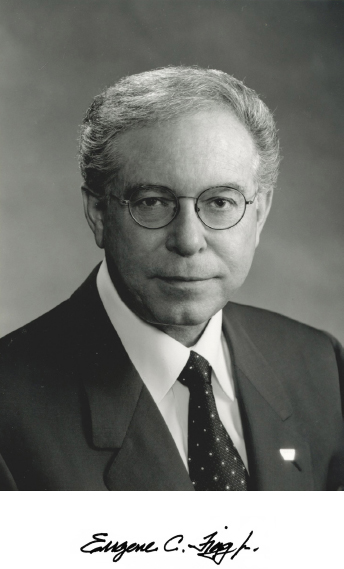1936–2002
Elected in 2001
“For leadership in architectural excellence, structural innovation, and efficient construction of major bridges.”
BY JEREMY ISENBERG
EUGENE CECIL FIGG JR., founder, president, and director of Bridge Art of the Figg Engineering Group, died March 20, 2002. He is widely recognized as the originator and leading practitioner in the United States in the field of concrete segmental bridge construction.
Born in Charleston, South Carolina, August 4, 1936, Gene followed the example of his father, a high-ranking civil engineer at the US Naval Shipyard, into the civil engineering program at the Citadel. There, he said, he absorbed the values of time management, leadership, and personal discipline that helped him to compete in the business world.
Gene Figg’s career was built on the premise that bridges should be not only functional and cost efficient, but also works of art. He inspired the practice of involving the local community in a new project so as to open the design process to local preferences. The practice, which he trademarked as FIGG Bridge Design Charette, introduces the technical requirements of the project to those who will be most affected by it and invites ideas that ensure respect for local context. His chosen media were the precast, segmental, and cable-stayed bridge types in which short segments of box girder are cast on shore, then erected and stabilized by inducing longitudinal compression through external stay cables or internal post-tensioning
tendons. Beginning with the Seven Mile and Long Key Bridges in the Florida Keys, he moved to longer and more dramatic projects including the I-275 Bob Graham Sunshine Skyway Bridge in Florida, which was completed in 1987 and was the first concrete cable-stayed bridge in the US with a single pylon and single plane of stays; Blue Ridge Parkway Viaduct around Grandfather Mountain in North Carolina, which introduced top-down progressive cantilever construction to protect the environment; and the Natchez Trace Parkway Arches with its graceful 582-foot precast concrete arch.
Recognition included the John A. Roebling Award for Outstanding Lifetime Achievement in Bridge Design (2000); three Presidential Design Awards (1984, 1985, 1995) through the National Endowment for the Arts; and inclusion in an exclusive list compiled in 1999 by Engineering News Record as one of 10 bridge designers selected worldwide who made a difference in the past 125 years. In 2002 he was awarded posthumously the Outstanding Projects and Leaders (OPAL) Award of the American Society of Civil Engineers, its highest honor for lifetime achievement in design. He is memorialized by the International Bridge Conference award, the Eugene C. Figg Jr. Medal for Signature Bridges. He founded the American Segmental Bridge Institute in 1988 and served as president from 1996 to 1998. He was a trustee for the National Building Museum and a member of the Citadel Development Board.
He is survived by his wife of 43 years, Ann Ruth Figg, and by four daughters, one of whom, Linda, is president and CEO of the firm Gene founded. Under her direction and guided by her father’s example the firm has completed such distinguished projects as the new I-35W Bridge in Minnesota, Penobscot Narrows Bridge and Observatory in Maine, Allegheny River Bridge near Pittsburgh, Fourth Street Bridge in Pueblo, Colorado, and US 191 over the Colorado River, Utah.





